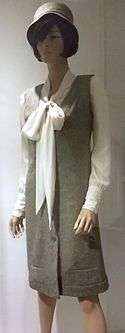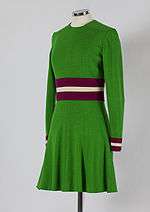Mary Quant
| Dame Mary Quant | |
|---|---|
.jpg) Mary Quant (1966) | |
| Born |
Barbara Mary Quant 11 February 1934 Blackheath, London, England, UK |
| Nationality | Welsh |
| Other names | Barbara Mary Plunket Greene[1] |
| Education | Goldsmith's College |
| Occupation | Fashion designer |
| Spouse(s) | Alexander Plunket Greene (1957-1990; his death); 1 son |
| Awards | DBE, FCSD, RDI |
| Website | Official website |
| Labels | Mary Quant |
Dame Barbara Mary Quant, Mrs Plunket Greene, DBE, FCSD, RDI (born 11 February 1934) is a Welsh fashion designer and British fashion icon.[2][3]
She became an instrumental figure in the 1960s London-based Mod and youth fashion movements.[2][4] She was one of the designers who took credit for the miniskirt and hot pants, and by promoting these and other fun fashions she encouraged young people to dress to please themselves and to treat fashion as a game.[5][6] Ernestine Carter, an authoritative and influential fashion journalist of the 1950s/60s,[7] wrote: "It is given to a fortunate few to be born at the right time, in the right place, with the right talents. In recent fashion there are three: Chanel, Dior, and Mary Quant."[8]
Early life
Quant was born in Blackheath, London on 11 February 1934, the daughter of Welsh teachers.[9] Her parents, Jack and Mary Quant, were both from mining families. They had been awarded scholarships to grammar school and had both attained first-class degrees at Cardiff University before they moved to London to work as schoolteachers.[10]
She went to Blackheath High School, then studied illustration at Goldsmiths College. After gaining a Diploma in Art Education from Goldsmiths, Quant began an apprenticeship at Erik, a high-end Mayfair milliner on Brook Street next door to Claridge's hotel.[10][11][12]
Marriage
She met her future husband and business partner, Alexander Plunket Greene in 1953.[12] They were married from 1957 until his death in 1990, and had a son, Orlando (b. 1970).
Fashion career

Early career
In November 1955, Quant and Plunket Greene teamed up with a photographer and former solicitor, Archie McNair, to open Quant's first shop on the King's Road in London called Bazaar, above "Alexander's", a basement restaurant run by Plunket Green.[12][13] In 1957, they opened the second branch of Bazaar, which was designed by Terence Conran.[10][13]
Successful designs from this early period included small white plastic collars to brighten up sweaters and dresses, bright stockings in colours matched to her knitwear, men's cardigans made long enough to be worn as dresses, and a pair of "mad" lounging pyjamas made by Quant herself which were featured in Harper's Bazaar and purchased by an American manufacturer to copy.[13] Following this, Quant decided to design and make more of the clothes she stocked, instead of buying in stock.[13] Initially working solo, she was soon employing a handful of machinists, and by 1966 she was working with eighteen manufacturers concurrently.
For a while in the late 1950s and very early 1960s, Quant was one of only two London-based high-end designers consistently offering youthful clothes for young people.[14][15] The other was Kiki Byrne, who opened her boutique on the King's Road in direct competition with Quant.[16]
Quant and the miniskirt

The miniskirt, described as one of the defining fashions of the 1960s,[17] is one of the garments most widely associated with Quant. While she is often cited as the inventor of the style, this claim has been challenged by others. Marit Allen, a contemporary fashion journalist and editor of the influential "Young Ideas" pages for UK Vogue, firmly stated that another British fashion designer, John Bates, rather than Quant or André Courrèges, was the original creator of the miniskirt.[18] Others credit Courrèges with the invention of the style.[19] However, skirts had been getting shorter since the 1950s—a development Quant considered practical and liberating, allowing women the ability to run for a bus.[20]
Quant later said "It was the girls on the King's Road [during the "Swinging London" scene] who invented the mini. I was making easy, youthful, simple clothes, in which you could move, in which you could run and jump and we would make them the length the customer wanted. I wore them very short and the customers would say, 'Shorter, shorter.'"[10] She gave the miniskirt its name, after her favourite make of car, the Mini,[21] and said of its wearers, "they are curiously feminine, but their femininity lies in their attitude rather than in their appearance ... She enjoys being noticed, but wittily. She is lively—positive—opinionated."[22]
In addition to the miniskirt, Quant is often credited with inventing the coloured and patterned tights that tended to accompany the garment, although their creation is also attributed to the Spanish couturier Cristóbal Balenciaga who offered harlequin-patterned tights in 1962[19][23] or to John Bates.[24]
Later career
In the late 1960s, Quant popularised hot pants and became a British fashion icon.[25][26] Through the 1970s and 1980s she concentrated on household goods and make-up, rather than just her clothing lines, including the duvet which she claims to have invented.[12]
In 1988, Quant designed the interior of the Mini (1000) Designer (originally dubbed the Mini Quant, the name was changed when popularity charts were set against having Quant's name on the car). It featured black and white striped seats with red trimming. The seatbelts were red, and the driving and passenger seats had Quant's signature on the upper left quadrant. The steering wheel had Quant's signature daisy and the bonnet badge had "Mary Quant" written over the signature name. The headlight housings, wheel arches, door handles and bumpers were all nimbus grey, rather than the more common chrome or black finishes. Two thousand were released in the U.K. on 15 June 1988, and a number were also released on to foreign markets; however, the numbers for these are hard to come by. The special edition Mini came in two body colours, jet black and diamond white. She is a Fellow of the Chartered Society of Designers, and winner of the Minerva Medal, the Society's highest award.[27]
In 2000, she resigned as director of Mary Quant Ltd., her cosmetics company, after a Japanese buy-out.[28] There are more than 200 Mary Quant Colour shops in Japan.[28]
Recognition
In 1963 Quant was the first winner of the Dress of the Year award. In 1966 she was appointed Officer of the Order of the British Empire (OBE) for her outstanding contribution to the fashion industry. She arrived at Buckingham Palace to accept the award in a cream wool jersey minidress with blue facings.[29] She was appointed Dame Commander of the Order of the British Empire (DBE) in the 2015 New Year Honours for services to British fashion.[30][31]
In 1990 she won the Hall of Fame Award of the British Fashion Council. Quant received an Honorary Doctorate from Heriot-Watt University in 2006.[32] In 2012, Quant was among the British cultural icons selected by artist Sir Peter Blake to appear in a new version of his most famous artwork – the Beatles' Sgt. Pepper's Lonely Hearts Club Band album cover – to celebrate the British cultural figures of his life.[33]
Books by Quant
- 1966: Quant by Quant — her first autobiography
- 1984: Colour by Quant
- 1986: Quant on Make-up
- 1999 Classic Make-up and Beauty Book
- 2011 Mary Quant: Autobiography — her second autobiography[34]
See also
- Daisy, doll designed by Quant
References
- ↑ Quant profile, thesteepletimes.com; accessed 7 May 2015.
- 1 2 Ho, Karen (3 July 2012). "The Brit List: Five Great British Fashion Designers". BBC America website. BBC. Retrieved 16 October 2012.
- ↑ "New Year Honours: Designer Mary Quant among Welsh recipients". BBC News. 30 December 2014. Retrieved 9 January 2015.
- ↑ Do Je-Hae (10 October 2012). "Mary Quant, British Fashion Icon". Korea Times. Retrieved 16 October 2012.
- ↑ McKinnell, Joyce (1964). Beauty. Harper Collins. p. 93. ISBN 9780007295586.
- ↑ "1966 trouser suit by Mary Quant.". Victoria and Albert Museum. Retrieved 12 July 2012.
- ↑ Barbara Burman accessed 12 July 2012 "Carter, Ernestine Marie (1906–1983)" profile, Oxford Dictionary of National Biography, Oxford University Press, 2004, oxforddnb.com; accessed 31 December 2014.
- ↑ Connikie, Yvonne (2006). Fashion of a Decade. Infobase Publishing. p. 17. ISBN 9781438118925.
- ↑ Kent, Jacqueline C. (2003). Business Builders in Fashion. Minneapolis, MN. pp. 96–99publisher=The Oliver Press, Inc. ISBN 1-881508-80-3.
- 1 2 3 4 Polan, Brenda; Tredre, Roger (2009). The Great Fashion Designer. New York: Berg. pp. 103–04. ISBN 978-1-84788-228-8.
- ↑ "Mary Quant". Victoria and Albert Museum website. Victoria and Albert Museum. 2011. Retrieved 24 February 2011.
- 1 2 3 4 Armstrong, Lisa (17 February 2012). "Mary Quant: 'You have to work at staying slim - but it's worth it'". The Telegraph. Retrieved 17 October 2012.
- 1 2 3 4 DelaHaye, Amy (2010). Steele, Valerie, ed. The Berg Companion to Fashion. Oxford: Berg. pp. 586–588. ISBN 1847885632.
- ↑ Denza, Vanessa. "Interview with Vanessa Denza MBE". Victoria and Albert Museum. Retrieved 2 June 2014.
- ↑ Waddell, Gavin (2004). How fashion works: couture, ready-to-wear, and mass production (Online-Ausg. ed.). Oxford, UK: Blackwell Science. p. 130. ISBN 9781118814994.
- ↑ O'Byrne, Robert (2009). Style city: how London became a fashion capital. London: Frances Lincoln. p. 14. ISBN 9780711228955.
- ↑ Ros Horton, Sally Simmons, 2007. Women Who Changed the World, p. 170
- ↑ "Garments worn by Marit Allen". Victoria and Albert Museum. Retrieved 12 July 2012.
- 1 2 Cartner-Morley, Jess (2 December 2000). "Chelsea girl who instigated a new era". The Guardian. Retrieved 12 July 2012.
- ↑ Barry Miles, 2009. The British Invasion: The Music, the Times, the Era, p. 194, Sterling Publishing Company, Inc., 2009.
- ↑ Barry Miles, 2009. The British Invasion: The Music, the Times, the Era, page 203, Sterling Publishing Company, Inc., 2009
- ↑ Seebohm, Caroline (19 July 1971). "English Girls in New York: They Don't Go Home Again". New York. p. 34. Retrieved 6 January 2015.
- ↑ Carter, Ernestine (1977). The changing world of fashion: 1900 to the present. London: Weidenfeld and Nicolson. p. 213. ISBN 9780297773498.
- ↑ Lester, Richard, John Bates: Fashion Designer, London, 2008.
- ↑ "Mary Quant profile". BBC website. BBC. November 2008. Retrieved 9 January 2011.
Quant was responsible for hot pants, the Lolita look, the slip dress, PVC raincoats, smoky eyes and sleek bob haircuts, but it was make-up that eventually made her company the most money.
- ↑ Hillary Alexander (9 January 2009). "Fashion designer Mary Quant to have design included on Royal Mail stamps". The Daily Telegraph. London, UK. Retrieved 9 January 2011.
Apart from the mini, Quant is credited with popularising white "go-go" boots, patterned tights, brightly-coloured "Paintbox" make-up, the micro-mini skirt, plastic raincoats, the "wet look", and hot-pants, which she designed in 1966, the year she received an OBE from the Queen for her services to the fashion industry.
- ↑ "These were the days that shook the world". The Guardian. 5 October 2016.
- 1 2 Gillan, Audrey (2 December 2000). "Mary Quant quits fashion empire". The Guardian. Retrieved 12 July 2012.
- ↑ "O.B.E. Dress by Mary Quant". Victoria and Albert Museum. Retrieved 12 July 2012.
- ↑ The London Gazette: (Supplement) no. 61092. p. N8. 31 December 2014.
- ↑ 2015 New Year Honours List, gov.uk; accessed 31 December 2014.
- ↑ "Annual Review 2006 : People, Honours and Awards". www1.hw.ac.uk. Retrieved 2016-03-30.
- ↑ "New faces on Sgt Pepper album cover for artist Peter Blake's 80th birthday". The Guardian. 2016.
- ↑ Quant, Mary (2012). Mary Quant: Autobiography. London: Headline. ISBN 978-0-7553-6017-8.
External links
- Mary Quant at the Fashion Model Directory
- film and television credits
- Mary Quant at the Victoria and Albert Museum, London Accessed June, 3. 2010.
- Mary Quant - Miniskirt - Icons of England